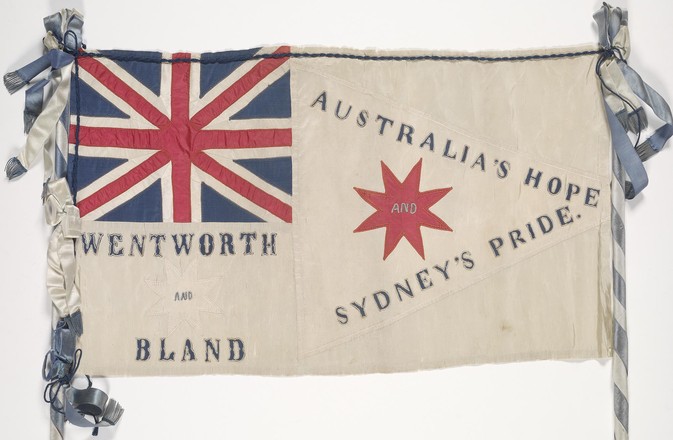NEITHER eggs nor tomatoes were thrown at
the candidates when the first legislative elections in Australian
history were held in Sydney on June 15, 1843. Both were too scarce,
in a year marked by a run on the Bank (of N.S.W.).
It is on record, however, that Sydney knew
cudgels, harpoons, sticks and palings, and the freedom to use them in
that distant year. A man was killed on Brickfield Hill. A number of
people were injured. Homes were entered and pillaged. A mob ruled the
city.
Up to that time legislation had been a matter
for the Governor, who sat and debated and voted with a Council
appointed by him. The June, 1843, elections were to bring some
representatives among the appointees in the Legislative Council. The
Governor would no longer sit or vote. It was a small but important
step toward self-government.
THE candidates for the Cumberland seat were W. C.
Wentworth, Dr. William Bland, Captain O'Connell,
Robert Cooper, and Mr. Hustler. On the ticket, the first four were
paired in the order named.
The candidates were publicly nominated at the
hustings in Macquarie Place on June 13.
Among the five thousand people gathered there
to hear the Mayor of Sydney, the candidates, and their nominators
speak, were more than a hundred almost fanatic supporters of Captain
O'Connell and Mr. Cooper.
These supporters, wearing green silk
streamers, crowded the hustings, tore down the Wentworth Bland banner,
assaulted whoever they found wearing a "true blue, currency
blue" rosette, and other- wise drowned out the voices of the
speakers with shouts and chanting.
There was worse to come on the great day of the
election.
On the advice of their candidates, the
Wentworth-Bland sup- porters began to record their votes as soon as
polling began at the six booths in the city.
In the absence of both police and soldiers,
Captain O'Connell's supporters were able to obstruct the booths and
suborn the voters from that hour onwards.
Had the limited franchise been extended to all
men, the mob in command of the city would have elected the captain
with a large majority.
THE first serious battle took place near the
polling booth on Flag Staff Hill, when the wearers of the green made a
vicious attack on Councillor Jones, who was also a whaler.
While mounted police came to the rescue from
one direction, up from the wharves came a band of the councillor's
crewmen, armed with handspikes and harpoons. The three forces met, tangled,
and overran the booth. Heads were broken and blood was drawn. Jones
and his crew retired to their boats and fled across harbour.
A man named Daniel Finnie was bludgeoned to
death in a mob fight on Brickfield Hill.
The rioters smashed all the windows of the
Australian Hotel in Lower George Street and did the same for Sam
Lyons, merchant.
The wife and children of a Jewish trader had
to run for sanctuary when the house was invaded and looted.
The small parties of mounted police were too few to
be effective.
As to the size of the mob, we have the story
of Captain Innes, a justice of the peace, who met and was overrun by
a fast moving force of between four and five hundred men led by
one John Mooney, who wore a long blue frock-coat, carried a
green flag on a pole, and was mounted on a black horse.
The mob went through Macquarie Place, up Bent
Street, and along Phillip Street to Hyde Park.
Captain Innes took a short cut to try again to
head them off, and again they swept him along with them.
On his third attempt to head the rioters,
someone struck the captain's horse, which bolted and knocked down a woman.
Innes stopped the horse at last and cantered back to see if the
woman had been hurt. He was surrounded by the mob and his life was threatened.
"THE Mounted Police endeavoured to protect
me," he said later, at the trial of John Mooney. "I wished them
to attempt to disperse the mob, but the sergeant-major told me not
to think of such a thing but to get away as quickly as I could."
Captain Innes took the advice and put his horse to the nearest fence.
"Such a scene of violent out- rage, riot,
and disorder I never before witnessed in my life," he testified.
The disorder became worse in the late afternoon,
when the polling figures showed Wentworth and Bland, with some 1,200
votes, to be at least 500 ahead of Captain O'Connell.
Wentworth later declared that none of his
supporters dared record a vote during the last two hours of the day.
As darkness fell on Sydney town, two parties
of the 80th Regiment were ordered out to assist the Mounted Police.
The soldiers seem to have done very little to stop the wrecking
and looting that night.
The strange thing is that only seven men were
arrested for all of this.
One of them, John Mooney, was discharged at an
inquest into the death of Daniel Finnie, who died at the hands of
"some person or persons unknown." The other six were not
even brought to trial.
Australia's first free election had ended.



 Back to list
Back to list